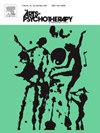Two ways to measure interpersonal synchrony in dance/movement therapy: Comparing accelerometer data with observational data
IF 1.5
3区 心理学
Q3 PSYCHOLOGY, CLINICAL
引用次数: 0
Abstract
Moving in synchrony with others is associated with heightened social engagement and cooperation between individuals. Creative arts-based approaches such as dance/movement therapy (DMT) incorporate nonverbal techniques to develop interpersonal synchrony and group cohesion, and to enhance kinesthetic empathy. While DMT commonly uses Laban Movement Analysis (LMA), an analytical assessment system to observe and interpret movement, it is subject to personal bias and observer fatigue. Therefore, our goal was to explore the utility of the accelerometer to objectively measure rhythmic synchrony (RS) and spatial synchrony (SS) with 14 middle school students during 10 weekly group DMT sessions and to examine changes in mean scores for RS and SS over three time points. A wrist-worn accelerometer and Laban Movement Analysis (LMA), were used to measure RS and SS between individuals in each group. Biometric and observational data were compared to observe trends between both data sets. Participants’ subjective experiences of wearing the device during movement were also investigated. Although no statistical significance was found in IS scores across groups, in comparing the two data sets, overall biometric scores of RS increased marginally between the three time points, and overall observational scores notably increased between T1 and T2 and decreased between T2 and T3. Group 2 demonstrated similar upward trends in both data sets. This study is the first to investigate the useability of the accelerometer to measure interpersonal synchrony in DMT. Although the findings are encouraging, further investigation is needed to provide definitive information on the usefulness of the accelerometer in this context. Limitations and suggestions for future research are included.
测量舞蹈/运动治疗中人际同步的两种方法:比较加速度计数据和观察数据
与他人同步移动与个人之间的社会参与和合作密切相关。以创造性艺术为基础的方法,如舞蹈/运动疗法(DMT)结合非语言技术来发展人际同步和群体凝聚力,并增强动觉共情。虽然DMT通常使用拉班运动分析(Laban Movement Analysis, LMA)这一分析评估系统来观察和解释运动,但它容易受到个人偏见和观察者疲劳的影响。因此,我们的目标是探索加速度计在10周小组DMT会议期间客观测量14名中学生节奏同步性(RS)和空间同步性(SS)的实用性,并检查RS和SS的平均得分在三个时间点上的变化。使用腕带加速度计和拉班运动分析(LMA)测量各组个体之间的RS和SS。比较生物特征和观测数据,观察两个数据集之间的趋势。参与者在运动过程中佩戴该设备的主观体验也被调查。虽然各组间IS评分差异无统计学意义,但在两组数据集比较中,RS的总体生物特征评分在三个时间点之间略有升高,总体观察评分在T1与T2之间显著升高,在T2与T3之间显著降低。第2组在两组数据中均表现出类似的上升趋势。本研究首次探讨了加速度计在DMT中测量人际同步性的可用性。虽然研究结果令人鼓舞,但需要进一步的研究来提供加速度计在这种情况下有用性的明确信息。最后提出了对未来研究的限制和建议。
本文章由计算机程序翻译,如有差异,请以英文原文为准。
求助全文
约1分钟内获得全文
求助全文
来源期刊

Arts in Psychotherapy
Multiple-
CiteScore
3.20
自引率
11.10%
发文量
66
期刊介绍:
The Arts in Psychotherapy is a dynamic, contemporary journal publishing evidence-based research, expert opinion, theoretical positions, and case material on a wide range of topics intersecting the fields of mental health and creative arts therapies. It is an international peer-reviewed journal publishing 5 issues annually. Papers are welcomed from researchers and practitioners in the fields of art, dance/movement, drama, music, and poetry psychotherapy, as well as expressive and creative arts therapy, neuroscience, psychiatry, education, allied health, and psychology that aim to engage high level theoretical concepts with the rigor of professional practice. The journal welcomes contributions that present new and emergent knowledge about the role of the arts in healthcare, and engage a critical discourse relevant to an international readership that can inform the development of new services and the refinement of existing policies and practices. There is no restriction on research methods and review papers are welcome. From time to time the journal publishes special issues on topics warranting a distinctive focus relevant to the stated goals and scope of the publication.
 求助内容:
求助内容: 应助结果提醒方式:
应助结果提醒方式:


